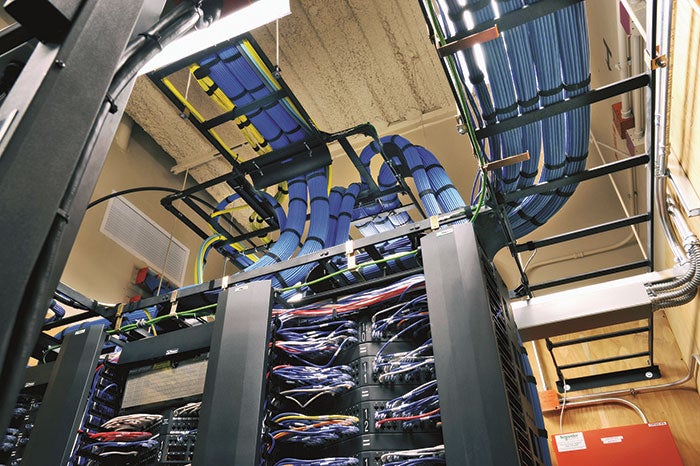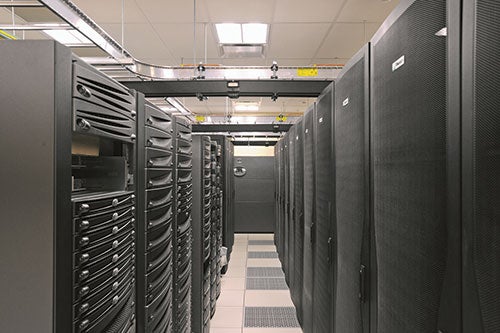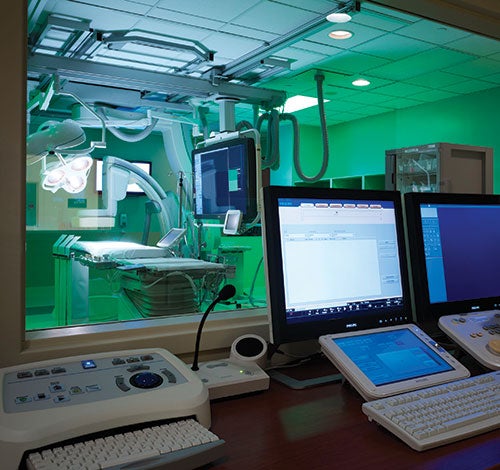Wireless infrastructure systems

Elmhurst (Ill.) Memorial Healthcare telecommunication rooms house switches and equipment that deliver Ethernet-based applications throughout the hospital.
The U.S. health care market is undergoing drastic transitions and health care providers are being challenged to improve the overall patient experience through reduced costs and improved value of care.
The successful deployment and management of technology can ease this transition. However, it’s important for facilities professionals to work with their information technology (IT) teams to support the planning and maintenance of technology infrastructure. Without such alignment, the infrastructure meant to support the new systems and programs may be the roadblock to achieving return on investment.
Nowhere is this more important than wireless networks. When planning for wireless access points (WAPs), building system sensors or wireless medical equipment, the conversation rarely turns to structured cabling. Despite its name, wireless activity has to be funneled through a cable at some point. As access point speeds and user demand continue to increase, health facilities professionals must start paying attention to the cabling infrastructure behind the WAPs.
Wireless as a platform
Wireless health care technology continues to grow and can deliver significant improvements to both service and cost. They include:
You may also like |
| Medical grade wireless infrastructures |
| Technology system commissioning |
| Managing medical equipment integration |
|
|
Medical equipment mobility. Universal room designs help to cut costs by reducing the number of overall rooms needed. By creating a space where equipment can be moved in or out easily, the room becomes more user-friendly and customizable to the needs of the patient. Rather than moving a patient around, universal rooms provide patient comfort while efficiently using expensive medical equipment where and when it is needed.
Patient mobility and remote access. Wireless medical equipment allows for patient mobility, again increasing comfort and giving providers the ability to remotely program and monitor systems and patient data. Wireless patient monitoring provides real-time access to patient data, allowing the patient freedom of movement and saving the physician time by not having to review the data in person.
Communication and entertainment. Wireless access has become an expectation for patients, guests and staff. Without proper coverage and capacity designed into Wi-Fi networks throughout a facility, health care facilities run the risk of frustrated and inefficient staff members who can’t fully utilize work-related systems such as email and electronic health records. Additionally, patients and guests expect Wi-Fi access to communicate and entertain themselves.

Elmhurst Memorial’s on-premise data center connects to telecommunications rooms throughout the hospital via fiber-optic cabling.
The strength of a health care facility’s Wi-Fi network is even more important with the popularity of Wi-Fi calling. Voice over Wi-Fi improves the quality of cellular service inside a building and places the infrastructure burden on facility owners rather than service providers. The number and location of access points and bandwidth (or the decision to allow Wi-Fi calling) on open networks has to be considered when designing a system.
While the communication aspect of wireless technology may not offer the most cost savings, it is certainly the most important for meeting patient expectations. Fast wireless access should be available in all patient and common areas because this aspect of wireless technology is what consumers are familiar with. A bad experience with a simple Wi-Fi connection can mean frustration for an already apprehensive patient.
Elimination of tripping hazards. Perhaps the most obvious benefit of wireless technology is the reduction or elimination of the tangle of wires around a patient. Wireless monitoring drastically reduces the risk of tripping and falling. In a field that is being pressed to reduce costs, the more falls that can be prevented through the elimination of physical hazards like wires, the better.
Sensors for building systems control. Hospitals, large medical office buildings and off-site facilities all can benefit from building automation systems that incorporate wireless sensors for monitoring and control. This infrastructure collects climate and occupancy data, giving the facilities team the ability to program and control each system remotely to meet the needs of a room or section of a building, ultimately reducing operating expenses.
Cabling infrastructure
The benefits of wireless technology in health care environments are well-established, but the cabling infrastructure that sits behind the wireless networks must be robust and designed to optimize the performance of both the cabling and the access points for years to come.

Plenum-rated elements connect to a wireless access point.
Coverage and capacity provide two approaches to improving the performance of a wireless network. With 100 percent wireless coverage in all areas of the facility, patients and staff will have the Wi-Fi experience they want and need. Because there are many opportunities for interference and dead zones in hospitals, a wireless site survey should be completed to determine coverage needs and to identify any remediation that is needed. It’s also a good idea to keep an inventory of all wireless devices and their corresponding operating frequencies to manage and limit interference between devices. The other concern with wireless is capacity, the ability of the network to provide reliable, responsive wireless access to the growing number of wireless devices that are competing for bandwidth.
Cabling infrastructure is designed to be replaced on a 10- to 15-year cycle. That’s great news when one considers that networking equipment likely will be replaced about every five years (and is a far larger investment). The bad news is that since 2007, WAP speeds have been increasing far faster than copper cabling speeds, which means the cabling installed today has to meet the needs of access points in 10 years, beyond the capabilities of the wireless industry’s crystal ball.
Increasing wireless speeds. Until recently, 1-gigabit cabling (Category 5e or Category 6) has been more than capable of meeting the bandwidth requirements of wireless access points. However, the latest revision to the wireless standard from the Institute of Electrical and Electronics Engineers, IEEE 802.11ac, has drastically increased access point speeds beyond the capabilities of 1-gigabit Ethernet, making a majority of the world’s installed cabling obsolete for wireless use.
While new construction should follow the guidance in the Telecommunications Industry Association (TIA) TSB-162-A, which calls for Category 6A (10-gigabit) copper cable or OM3 or higher-fiber cable, a new Ethernet technology called NBASE-T is designed for legacy applications and extends the life of existing Category 5e and Category 6 copper cable.
NBASE-T was developed by an alliance of wireless and cabling industry stakeholders who recognized the gap between the capabilities of 70 percent of the world’s cabling and the next generation in wireless access speeds. An NBASE-T-capable switch works with existing Category 5e or Category 6 cable to provide either 2.5-gigabit or 5-gigabit Ethernet speeds to a WAP. With this technology, health care facilities can add bandwidth and improve the capacity of their wireless network by replacing the switch and access points without having to pull new cable. This provides an option to improve bandwidth without disturbing operations for an extensive length of time and risking noncompliance with infection control measures.
Copper or fiber? With the speed of WAPs increasing faster than the capabilities of copper cabling, why not turn to fiber-optic cable? If the argument is solely about speed, the TIA TSB-162-A, “Telecommunications Cabling Guidelines for Wireless Access Points,” guide allows for either two Category 6A or higher copper cables, or two-fiber multimode optical fiber of OM3 or higher. While the copper vs. fiber decision is typically broader than WAPs, one distinct advantage of copper is the ability to deliver power over Ethernet (PoE).
WAPs are the second most common application for PoE, with expected adoption to be at least 80 percent of access points by 2020. With a PoE-enabled switch in place, using this technology to provide power to WAPs can equal significant cost savings at installation. PoE eliminates the need for electrical wiring, meaning no cost for an additional wire to each access point or for the electrical installation. Additionally, PoE provides increased flexibility in locating the WAP because the WAP doesn’t have to be located near an existing electrical outlet.
If PoE is used to power access points, the cabling will vary based on how many watts need to be delivered to the end device and the size of the cable bundles. For any application requiring less than 49 watts of power at the end device, and with small bundle sizes or a single cable, Category 5e and Category 6 cable work well. If more power or larger bundle sizes are needed, the cabling industry recommends Category 6A cable with its larger wire gauge.
The biggest concern with PoE is that it creates heat. The standards recommend that, when bundling cable for PoE, the center cable cannot increase in temperature more than 15 degrees Celsius above the ambient room temperature. The larger wire gauge of Category 6A cable provides less resistance for power, which ultimately creates less heat and makes for a more efficient PoE cable.
Making the transition
The health care industry is at a crossroads between antiquated operating models and a plethora of new technological opportunities.
To effectively transition to a consumer-oriented health care model through proper deployment of technology, hospitals and other health care facilities require full collaboration between facilities and IT professionals, especially if the cabling infrastructure decisions are owned by one party and the systems, programs and network decisions are owned by another.
With so much health care technology going wireless, a high-quality, top-performing cabling infrastructure sitting behind the network is vital.
Lindsey Kuhlmann is business development manager at Panduit, Tinley Park., Ill. She can be reached at Lindsey.Kuhlmann@panduit.com.





